The Grand Opening of RISE 2025: Day 1 & Day 2 - Special Issue
This issue captures the spirit of Day 1 & Day 2 of RISE 2025—spotlighting the ideas, discussions, and breakthroughs that are reshaping the landscape of healthy aging in India and globally.
The much-anticipated RISE for Healthy Aging 2025 conference opened with a spirit of enthusiasm and purpose, paving the way for three impactful days focused on driving progress in science, policy, and innovation to support healthier, longer lives.
The first day of the three-day RISE for healthy aging—a meeting of minds, missions, and movements for a healthier future unfolded with an opening ceremony followed by an opening address by Prof. Deepak Saini, the convener of Longevity India. Prof. Saini shared his scientific journey- investigating molecular mechanisms of aging, such as DNA damage, ROS, and CXCR4 signalling—to creating sophisticated 3D and fractionated aging models, which led to the foundation for Longevity India. He also highlighted flagship efforts like the BHARAT study and the use of AI for accelerating biomarker discovery to support healthy aging in India.
Prof. Saini’s opening address was followed by Prof. Brian Kennedy’s (NUS, Singapore) keynote, who has led efforts to make Singapore a healthy longevity hub. He emphasized the importance of transitioning from a reactive "sick-care" approach to a proactive healthcare model focused on prevention. Highlighting the harmful effects of stress and the need for physical activity, he raised concerns about the potential long-term health consequences of intense academic pressure on Indian children. He stressed the need for a unified framework to effectively benchmark and guide longevity interventions. Together, the talks emphasized a transformative shift toward integrative, preventive approaches in aging research to promote long-term health and well-being.
Several distinguished speakers presented key insights into the biological underpinnings of aging and the emerging strategies to promote healthy longevity. Here are the key talk highlights from different sessions:
Insights from Biology Session:
To highlight a few, senior biogerontologist Dr. Suresh Rattan (Associate Professor Emeritus, Aarhus University, Denmark) highlighted that aging results from the imperfect nature of biological systems and is shaped by evolution to ensure essential survival, not to prevent aging itself. He emphasized that hormetic interventions like exercise, fasting, and mental engagement can promote health by stimulating the body’s adaptive repair mechanisms. Complementing this perspective, Prof. Satchidananda Panda (Salk Institute, USA) emphasized the vital role of circadian rhythms in regulating sleep, digestion, body temperature, melatonin production, and the gut microbiome. He highlighted time-restricted feeding (TRF) as a strategy to manage chronic diseases and promote healthy aging by syncing eating patterns with the body’s natural clock. Disruptions in lifestyles—like shift work, jet lag, and late-night light exposure—can increase disease risk.
Mechanisms, Pathways, and Perspectives Session: This session underscored a central theme—the crucial role of biological mechanisms and molecular markers in understanding and addressing the aging process. The talks highlighted fundamental biological mechanisms—ranging from mitochondrial dysfunction and micronutrient signalling to cellular senescence.
Prof. Keshav Singh (UAB, USA) presented his compelling study using a genetically engineered mouse model, that mitochondrial dysfunction is not only a driver of aging but also a reversible target. This model offers a powerful tool for investigating organ-specific aging and advancing mitochondria-focused therapies. Shifting from organelle biology to nutritional genomics, Dr. Arnab Mukhopadhyay (NII, New Delhi) expanded the conversation by exploring how vitamin B12—acquired through microbial partners—interacts with host genes to influence longevity. His findings suggest that dietary micronutrients may serve as both biomarkers and modulators of biological age.
At the systemic level, Prof. Hiroshi Kondoh (KUH, Japan) addressed aging from the viewpoint of resilience —a dynamic measure of the body’s capacity to maintain function under stress as a functional marker of aging. He presented his group’s work on senotherapeutics—specifically senolytics (which eliminate senescent cells) and senostatics (which suppress their pro-inflammatory signals)—demonstrated the potential to rejuvenate metabolic function and enhance physiological resilience. Through blood metabolomics and glycolysis profiling, his team identified impaired metabolic adaptability as both a marker and a therapeutic target in aging populations.
Together, these talks converge on a powerful message: tracking and modulating molecular and cellular biomarkers offers a transformative path toward predicting, monitoring, and potentially reversing aspects of aging, moving us closer to personalized longevity medicine.
Pathologies of Aging session, the discussions focused on how aging alters tissue environments—through senescence, inflammation, and structural changes—leading to higher risk and progression of age-related diseases. As age-related diseases continue to pose significant health challenges, understanding how biological changes in aging tissues contribute to disease risk is crucial for improving health outcomes in the elderly. Dr. Mark LaBarge (Associate Prof. City of Hope, California) highlighted how aging alters the mammary gland by changing epithelial identity, extracellular matrix composition, and cell interactions, which may disrupt genomic stability and increase cancer risk. His team uses human breast tissue models to identify strategies that preserve tissue health and delay cancer onset in aging individuals.
Following an insightful Day 1, which focused on Mechanisms and Pathways of aging, Day 2 shifted focus to Translational research and Clinical perspectives—spotlighting industry-driven innovations, products, and approaches aimed at promoting longevity and healthy aging.
Following their discussion, Dr. Matt Kaeberlein (Optispan, USA) presented Medicine 4.0: Optimizing health through Longevity science, tracing the shift from reactive, disease-focused care (Medicine 2.0) to proactive, personalized approaches (Medicine 3.0). While Medicine 3.0 introduced lifestyle interventions, it remains fragmented and often compromised by pseudoscience. Medicine 4.0 advances beyond the fragmented lifestyle focus of Medicine 3.0 by using AI, precise diagnostics, and evidence-based tools to target the biology of aging. With reliable measures like bloodwork and DEXA scans, it avoids unproven trends and aims to extend healthspan. This sets the foundation for Medicine 5.0, where chronic diseases may be delayed into old age.
Another insightful lecture by Dr. David Furman (Buck Institute for Research on Aging, California, USA) highlighted that aging is better understood than people think, especially the role of chronic inflammation. He favors inflammatory clocks, which predict health outcomes like frailty and mortality more accurately than traditional epigenetic clocks and can be measured easily using saliva. His team runs longevity clinics using these tools for personalized aging care. Dr. Furman’s lab also studies how space conditions accelerate aging by exposing human blood and organoids to microgravity, speeding up aging to better understand its effects. They combine this with advanced molecular analyses and AI to link visible signs like facial changes to organ aging. Their goal is to create low-cost, non-invasive tools to track aging and detect diseases early, helping people optimize their health over time. Their BeyondAge program offers detailed aging reports to guide personalized interventions.
Fireside Chat and Panel discussions:
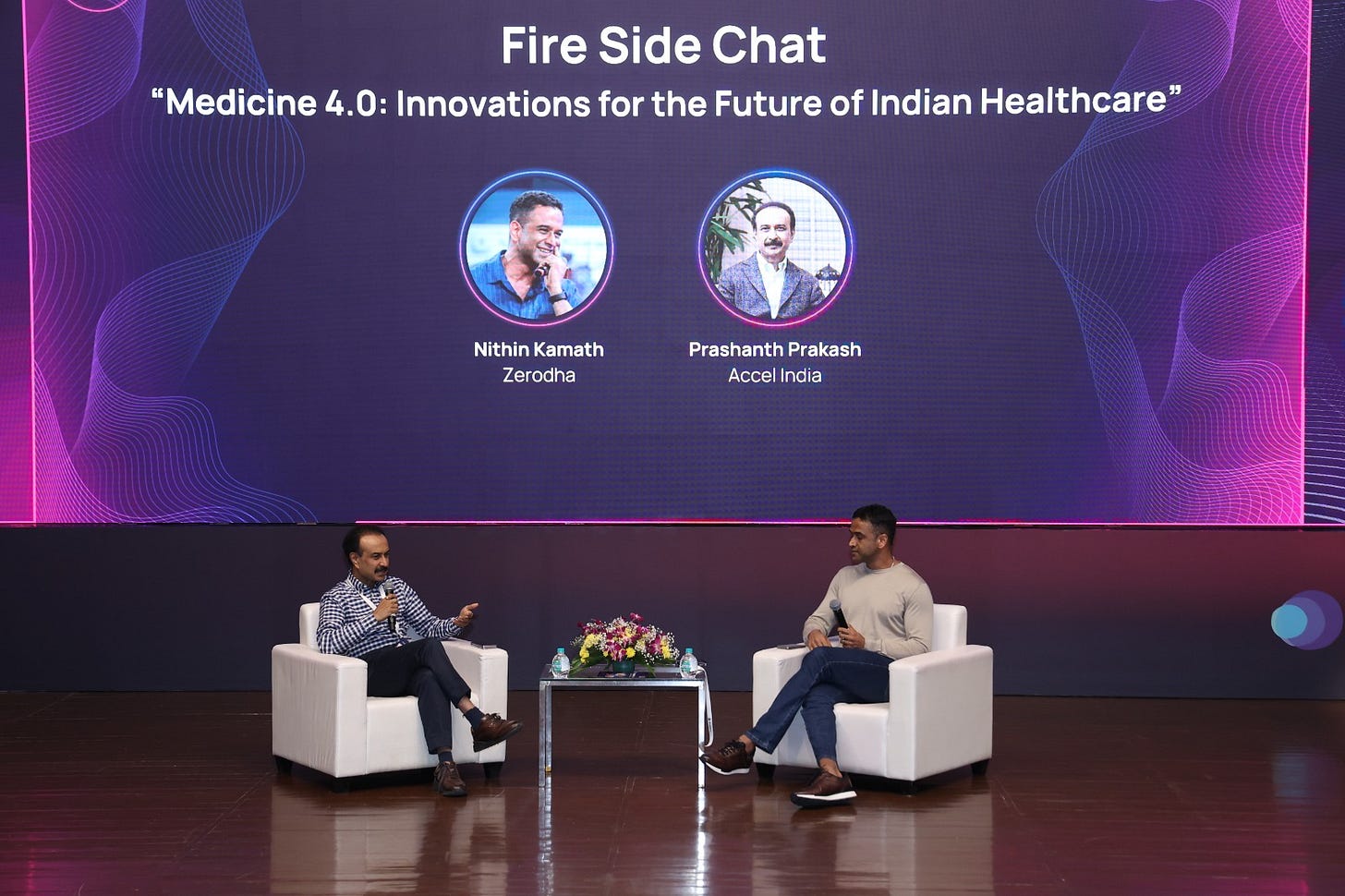
Starting the day with a fireside chat on Medicine 4.0: Innovations for the Future of Indian Healthcare: Mr.Nithin Kamath (CEO, Zerodha) and Mr.Prashanth Prakash (Founding partner of Accel India) discussed the limitations of Medicine 3.0—poor infrastructure and lack of personalization—making advanced care accessible only to a few. They highlighted how Medicine 4.0, powered by AI and data, could transform healthcare into a more scalable, preventive, and personalized system. Mr. Kamath, drawing from personal experiences, noted the contrast between rushed care in India and more thoughtful care abroad. They emphasized that awareness, not affordability, remains the biggest barrier to adoption. The discussion stressed nutrition literacy, strength training, and proposed a new AI-supported care coordinator role. Startups like Fitto and Nora were highlighted as early steps toward this transformative ecosystem.
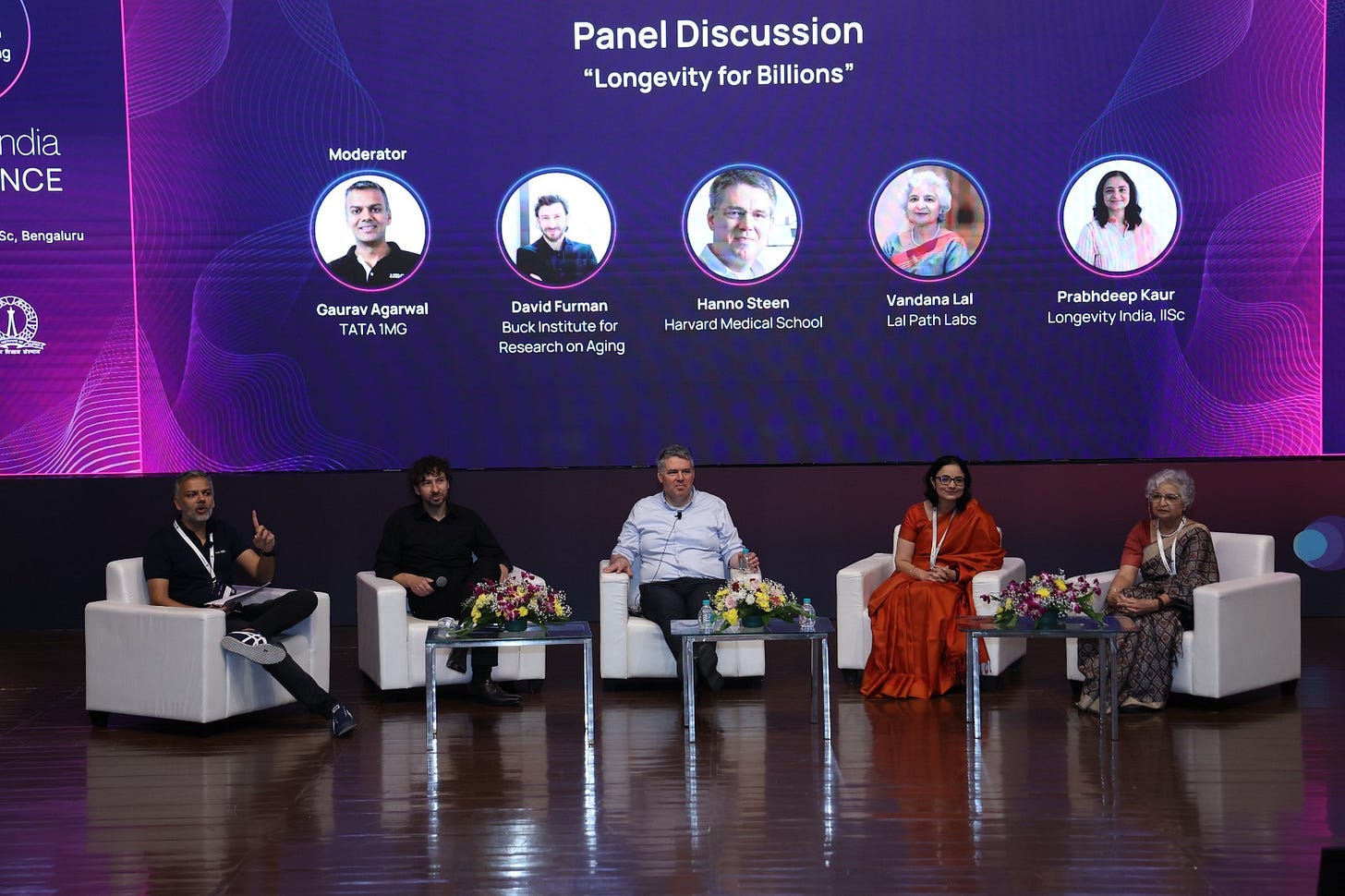
“Longevity for Billions” panel discussion: moderated by Mr. Gaurav Agarwal (Tata 1MG) brought together diverse voices to explore how cutting-edge diagnostics—like proteomics and inflammation-based aging markers—can be scaled for public health impact in India, despite systemic and infrastructural challenges. Dr. Vandana Lal (Lal Path Labs) emphasized the need to improve health-seeking behavior in rural areas through awareness and education, suggesting that locally developed, validated, and bundled diagnostics could reduce costs. Dr. David Furman highlighted the importance of standardization and reimbursement to drive adoption, stressing that biological age should guide diagnostics, not chronological age. Dr. Prabhdeep Kaur (IISc) pointed out that scalable diagnostics must demonstrate clear population-level benefits, and that India must now shift focus from infectious to pre-disease diagnostics. Dr. Hanno Steen (Harvard Medical College) suggested simple sampling innovations like dried blood spots to overcome infrastructure limitations. The panel collectively agreed on the need for grassroots awareness, public-private partnerships, stronger academia-industry collaboration, and data-driven approaches to define population baselines. They also acknowledged that with more funding and systemic support, the path to scalable, equitable diagnostics can be accelerated.
Parallel Sessions:
A parallel session spotlighted Lifestyle Medicine and Longevity interventions, and Ayurveda in promoting holistic health, emphasizing their vital roles in fostering longevity through integrated approaches to wellness and the prevention of age-related diseases.
Lifestyle factors—such as nutrition, exercise, sleep, stress management, and social connections—play a crucial role in promoting healthy aging as mentioned by Dr. Alexander Thomas (Association of Healthcare Providers, India). He advocated for a shift toward a curative medical model that focuses on lifestyle interventions to prevent and even reverse non-communicable diseases (NCDs). Adding to it, heart disease leads to around 17 million deaths each year—more than twice the number of deaths caused by the COVID-19 pandemic, which totalled about 7 million. Dr. Samuel Hansdak (CMC, Vellore) emphasized the urgent need to address the root causes of NCDs through a holistic approach centered on lifestyle, social connections, and well-being. He referenced landmark studies linking NCDs to lifestyle factors, while also pointing to emerging risks like climate change, screen exposure, and chronic stress. Concluding with insights from the Maori community, he credited their longevity to strong social ties and a sense of purpose, defining health as a balanced state restored through healing.
Despite biomedical advances, the gap between healthspan and lifespan continues to grow. Dr. Kishore Kumar Ramakrishna (NIMHANS, Bengaluru) and Dr. Hemant Bhargav (NIMHANS, Bengaluru) highlighted the value of integrative approaches—combining Ayurveda, yoga, and clinical psychiatry—for mental health and healthy aging. Dr. Kishore emphasized using yoga as a standalone treatment for mild depression and incorporating Ayurvedic herbs like Brahmi and Mandukaparni for neuroprotection. Dr. Hemant explained how yoga enhances brain function, reduces stress, and supports cognitive health, especially in aging and menopausal populations, underscoring the need for further research and integration into public health strategies.
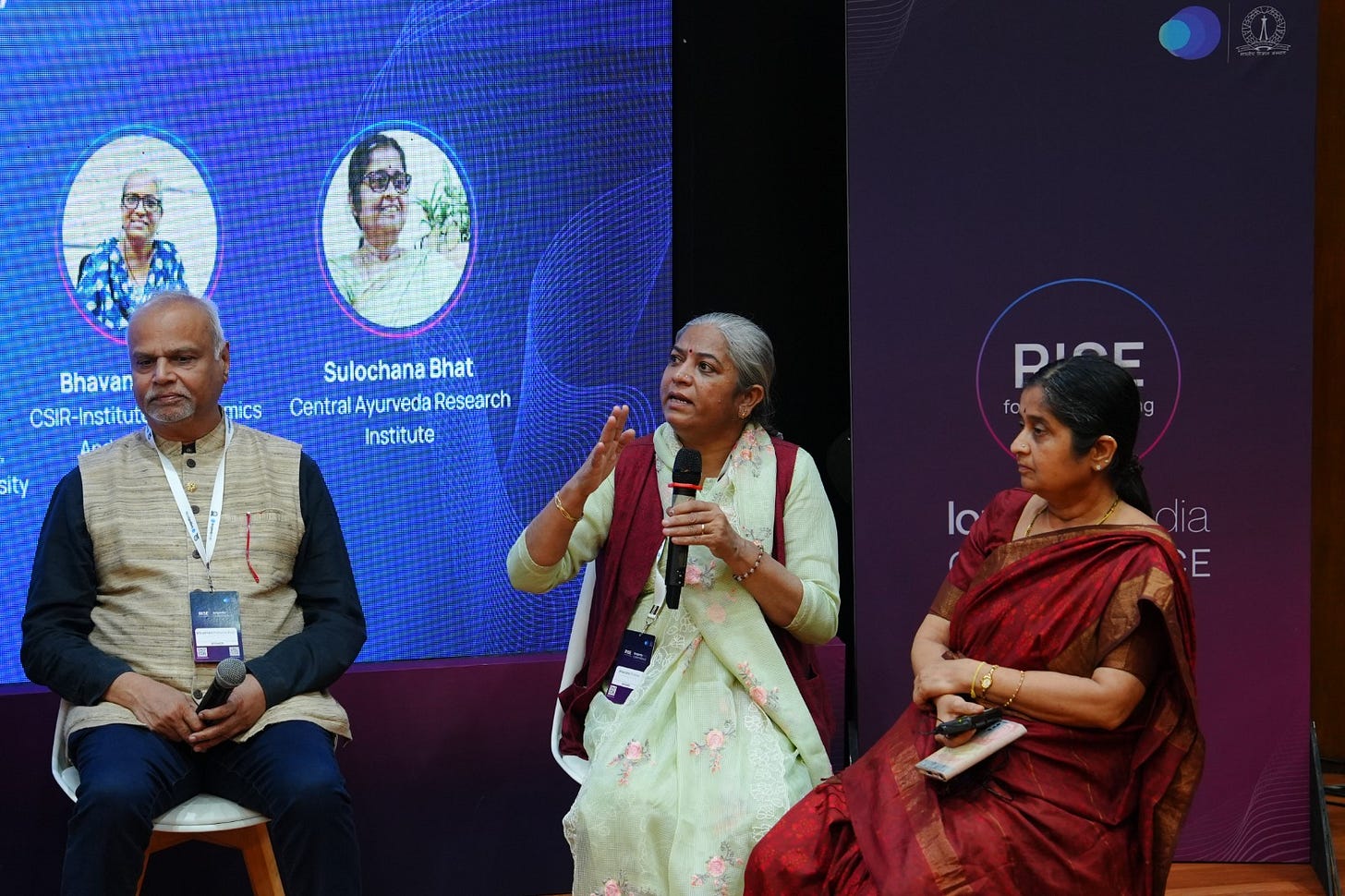
The focus was on personalized, holistic care that addresses physical, mental, social, and spiritual well-being. Drawing from both scientific research and traditional wisdom, the session highlighted the potential of integrated strategies to address the complexities of aging.
The Aging Brain: Addressing dementia in India requires a unified focus on early detection, understanding disease mechanisms, and raising awareness. In the parallel session on The Aging Brain, Dr. Thomas Gregor Issac (Center for Brain Research, IISc) highlights the urgent need for updated dementia data in India and outlined his large-scale urban-rural study to understand disease patterns. He emphasized strategies like early biomarker-based detection, targeting at-risk groups, and promoting cognitive resilience to reduce dementia burden and improve quality of life. Dr. Mounia Chami’s (INSERM, France) research shows that dysfunctional mitochondria accumulate in Alzheimer’s disease and that metformin can restore mitochondrial function, reduce amyloid-beta levels, and improve memory. This suggests that targeting mitochondrial dysfunction and mitophagy could offer a promising new treatment strategy for AD. Ramani Sundaram (Dementia India Alliance) stresses the importance of increasing awareness, especially in rural areas, and integrating physical and mental health care, with the Dementia India Alliance playing a key role in support and education. Together, these efforts aim to reduce dementia’s impact and improve quality of life nationwide
The final panel on Hormones & Fertility-Age-Old questions, New paradigms wrapped up Day 2 by opening up both new questions and promising solutions in the field. Moderated by Dr. Suramya Asthana (IISc), the discussion highlighted the urgent need to boost funding and interest in reproductive longevity, which currently lags behind pet longevity research. Dr. Brian Kennedy emphasized the impact of early ovarian decline on post-menopausal health and shared advances in pre-clinical research on geroprotectors and IVF, while also noting the challenges in translating findings from mice to humans. He advocated for carefully administered hormone replacement therapy (HRT) and discussed cutting-edge ideas like egg preservation in space. Dr.Vritti Lumba (Longevity Entrepreneur) brought attention to India’s earlier onset of perimenopause and stressed a prevention-focused approach, personalized HRT, and lifestyle factors such as diet, sleep, and exercise, especially in addressing the rising incidence of PCOS. Prof. Ramray Bhat (Longevity Investigator, IISc) pointed out the wealth of multiomics data available but called for better frameworks to integrate this knowledge, sharing his research on fallopian tube aging. Together, the panel underscored the complexity of reproductive aging and the need for tailored, multidisciplinary strategies to improve women’s health span.
Longevity India team’s research highlights: Longevity Investigators from the Longevity India Initiative at IISc shared brief updates on their ongoing research. While each investigator works with distinct model systems, they are united by a common goal: understanding the biology of aging.
Prof. Ramray Bhat (IISc) shared his work on how senescent microenvironments promote ovarian cancer progression. He showed that senescent mesothelial cells secrete glycan-rich ECMs that support cancer cell adhesion and invasion—unlike younger cells that resist tumour spread. Using a multi-organ chip model, his team identified methylglyoxal, a glycolysis by-product linked to aging and diabetes, as a key oncometabolite that induces endothelial senescence and disrupts tissue barriers, aiding cancer cell migration. These findings highlight how age-related metabolic and matrix changes drive tumour invasiveness and suggest new strategies for age-adapted cancer therapies.
Following the discussion, Prof. Siddharth Jhunjhunwala (IISc) highlighted the complex, non-linear effects of aging on immune function through insights from the ongoing BHARAT study. The study revealed significant shifts in naïve and memory T cell populations in older individuals, potentially explaining their reduced immunity. Although innate immune cells appear largely unchanged in phenotype, their potential functional decline with age remains a key area for further exploration.
Prof. Subba Rao Gangisetty (IISc) and Dr. Shovamayee Maharana (IISc) both work with skin as their model system to study aging. Prof. Rao focuses on lysosome remodelling and secretion in keratinocytes, while Dr. Maharana investigates age-related changes in biomolecular condensates, aiming to understand and potentially reverse skin cell senescence using well-known anti-aging drugs to promote healthy skin aging.
The rich discussions ignited new collaborations across disciplines, highlighting a collective drive to bridge science and society in the longevity space. As the dialogue continues, Day 3 promises to carry this momentum forward—stay tuned for highlights in our next newsletter.


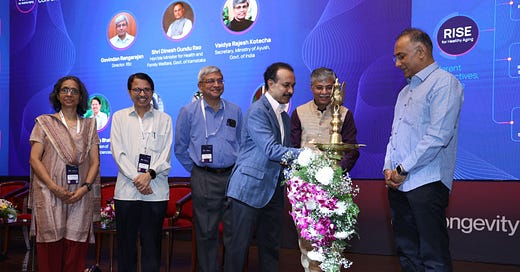



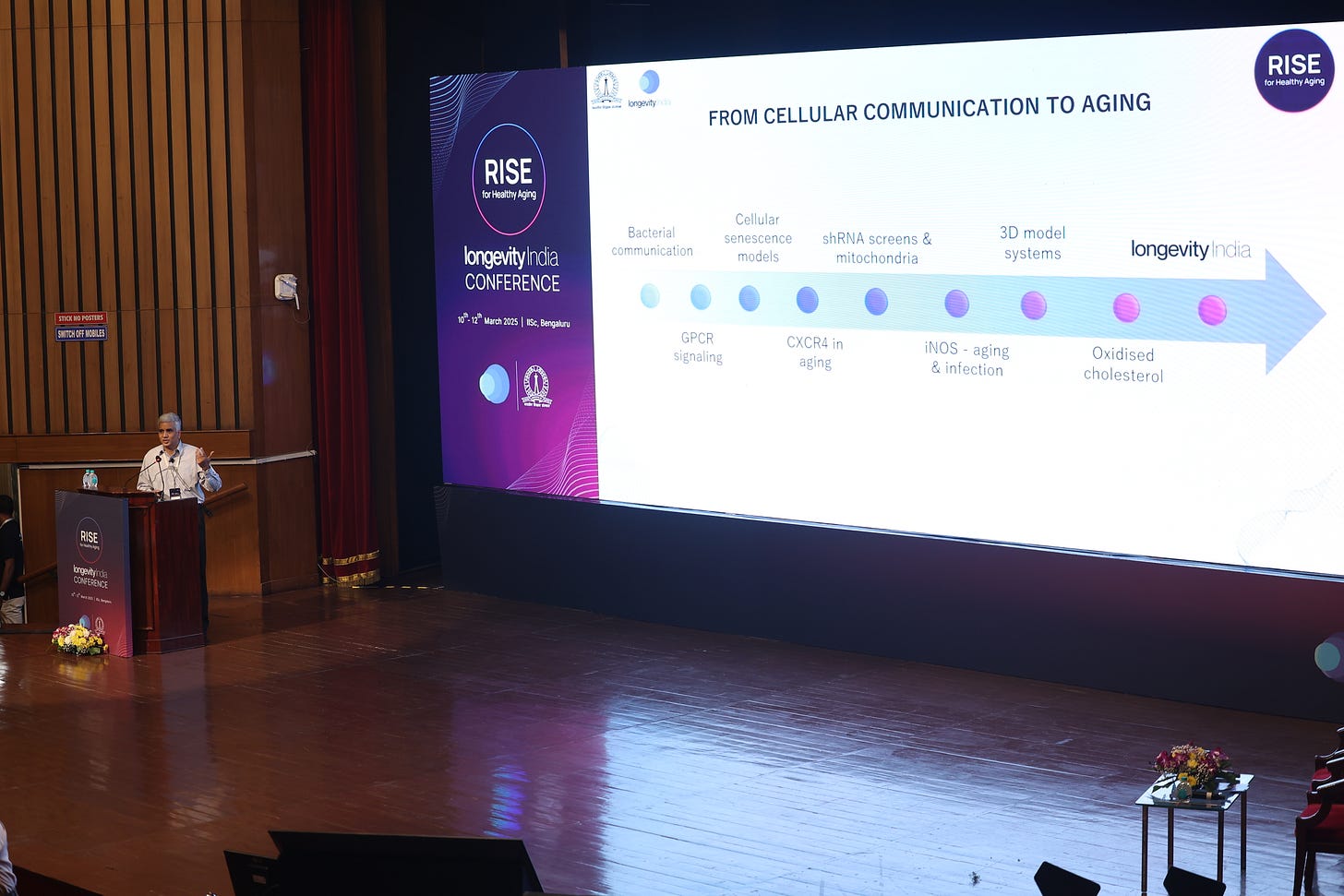


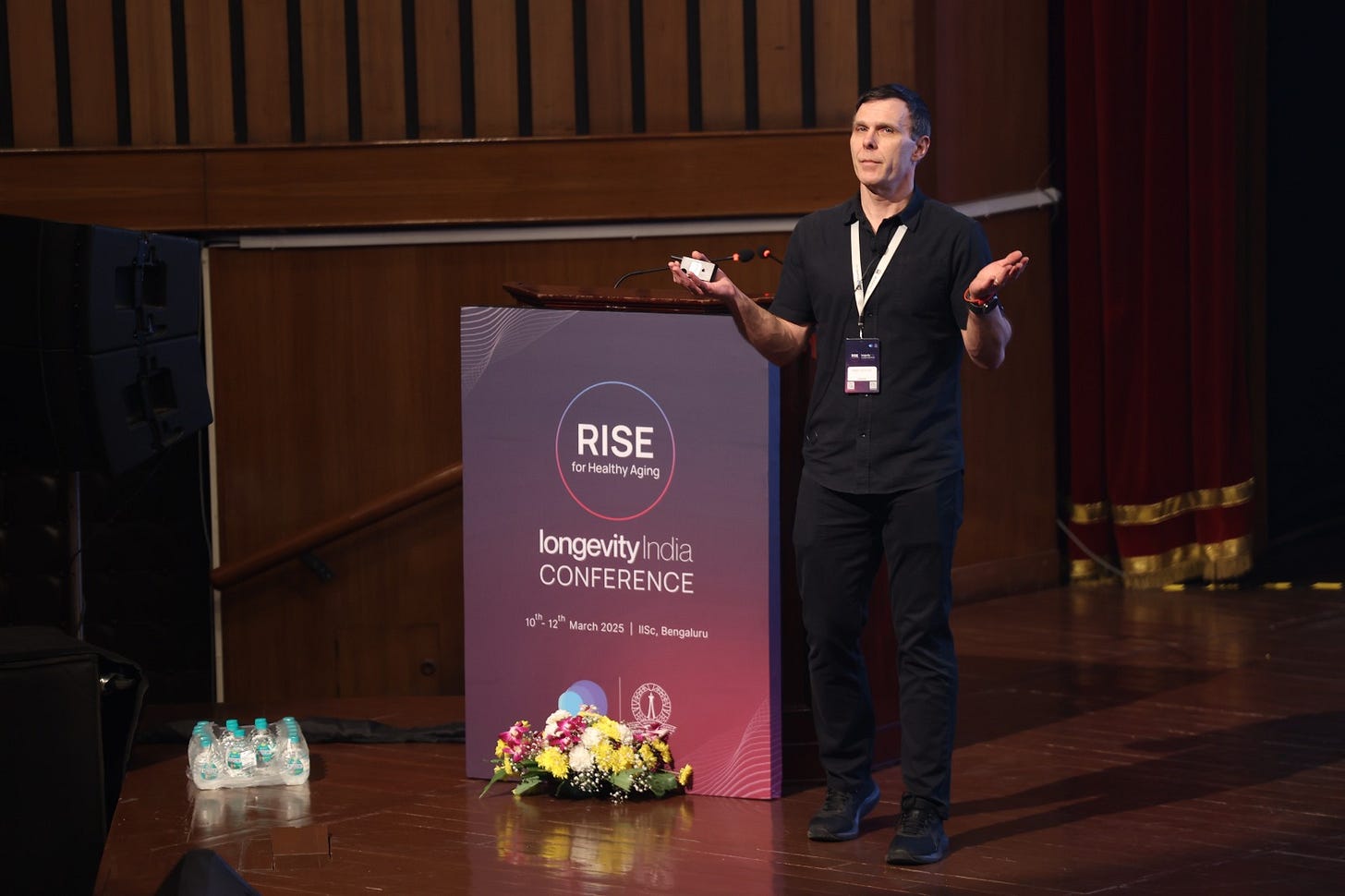

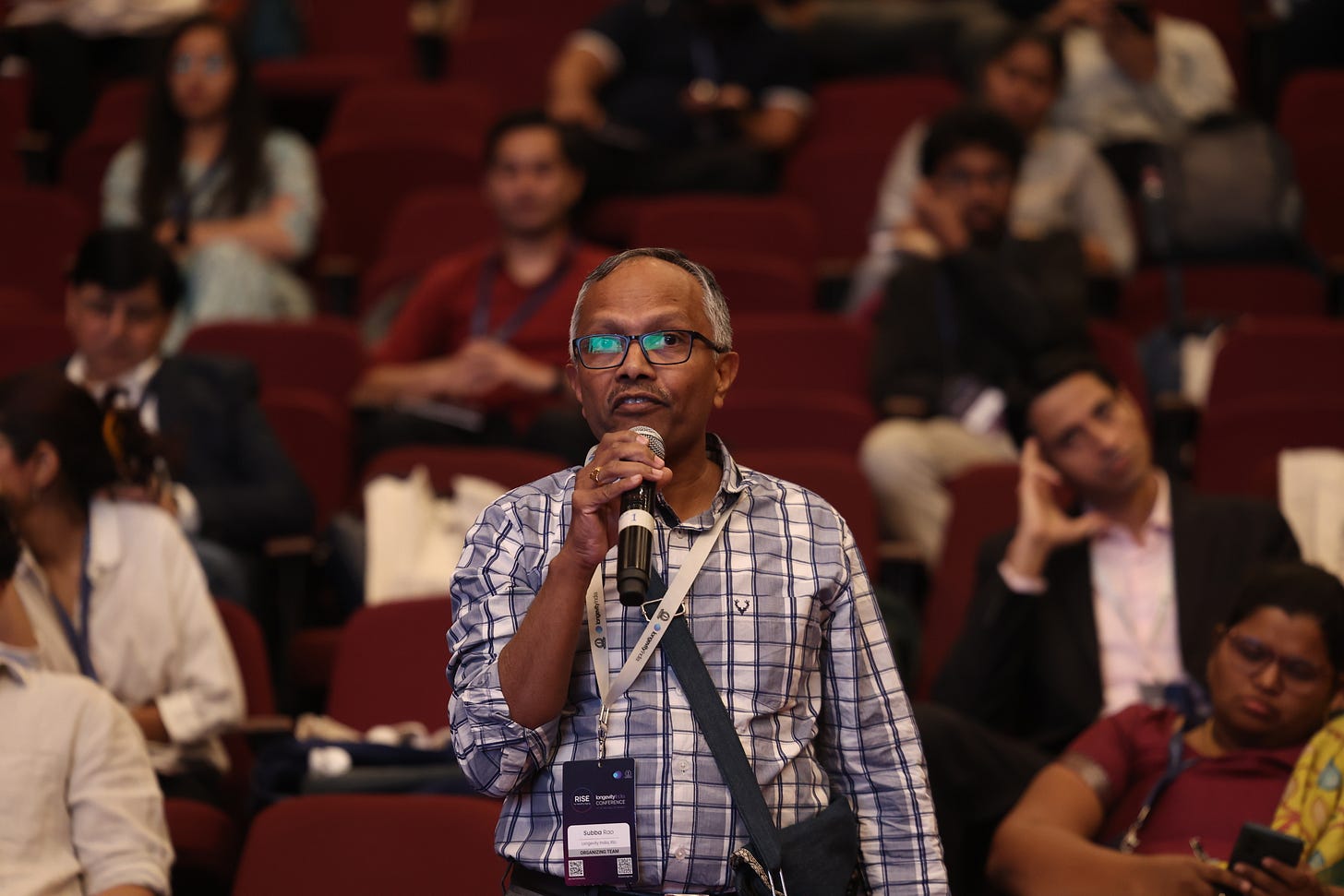
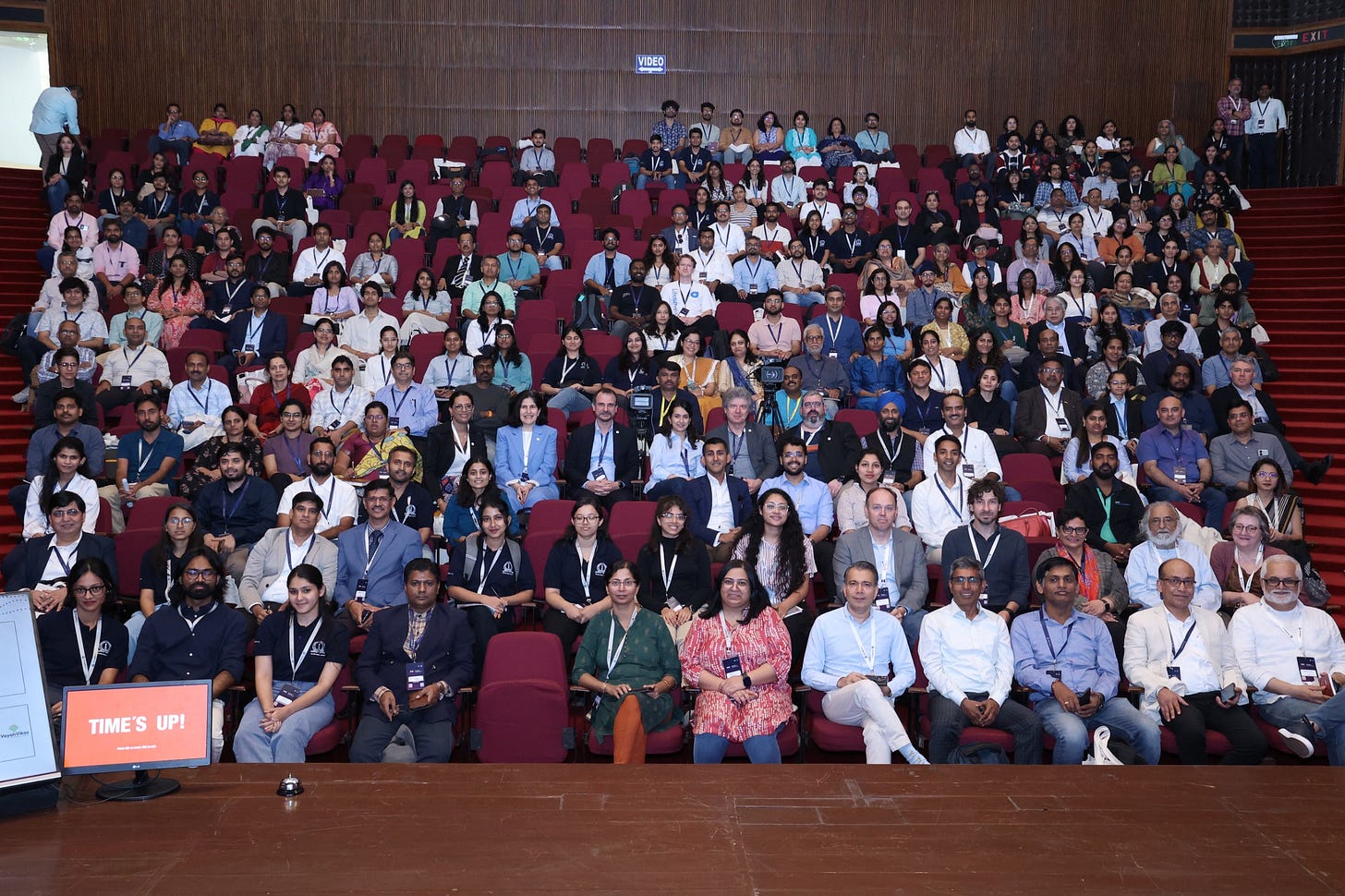

Are there any recordings of these sessions?